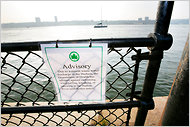
Photo: Monika Graff for The New York Times
The timing could not have been worse. In the midst of a blistering heat wave in New York City, what has been described as a “catastrophic fire” at the North River Waste Water Treatment plant yesterday allowed millions of gallons of untreated sewage to be discharged from Manhattan into the Hudson and Harlem Rivers. Officials are warning New Yorkers and New Jersey residents on the harbor against swimming, fishing or launching boats in the Hudson and at four city beaches on Staten Island and in Brooklyn.
After Blaze, Sewage Floods City Rivers
The rivers that run into New York Harbor will be unfit for recreational activities at least through Sunday because of a catastrophic fire that shut down one of the city’s largest sewage treatment plants, the city’s health department said Thursday.
The city has nearly 600 miles of coastline. The health warning covers the waters from the Verrazano-Narrows Bridge to the Hudson, Harlem and East Rivers. People should avoid activities that could involve contact with those waters.
On Tuesday, just a day before the fire, tests on city waters found them to be in “excellent” condition and fit for swimming, said John Lipscomb, the manager of water quality sampling programs for Riverkeeper, an environmental advocacy group.
By Thursday, public boat launches on the Hudson had been shut down. People fishing from piers were told the water was unsafe. Swimmers young and old were being turned away from Riverbank State Park, which sits atop the treatment plant, has three swimming pools and other amenities, and was closed because it had no electricity.
A beach pollution advisory was issued Thursday evening for South, Midland and Cedar Grove Beaches on Staten Island and Sea Gate in Brooklyn. Updates were to be posted on the department Web site, www.nyc.gov/health.

I wonder if the fire has anything to do with the more highly tuned state of today’s diesel engines. The ones in ships have had a number of fires recently that seem to be more than the historical norm. Could this be a consequence of the Tier 2 and 3 requirements and the electronic controls required to meet them making it possible or necessary to take operating parameters closer to the edge of the envelope?